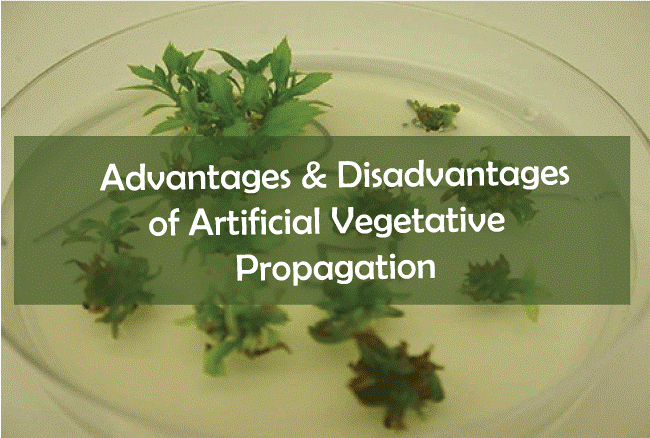Advantages and Disadvantages of artificial vegetative propagation

Artificial vegetative propagation refers to the process of creating new plants from existing plant parts, such as stems, leaves, or roots, without the involvement of seeds. This method is commonly used in agriculture and horticulture for the propagation of desirable plant traits.
Here are some advantages and disadvantages of artificial vegetative propagation:
Advantages:
-
Preservation of Desirable Traits:
- Plants produced through vegetative propagation inherit the exact genetic characteristics of the parent plant. This ensures the preservation of desirable traits, such as disease resistance, fruit quality, or specific flower characteristics.
-
Faster Plant Development:
- Vegetative propagation is generally faster than growing plants from seeds. This can be particularly advantageous in agriculture and horticulture, where a quick turnaround is desirable.
-
Uniformity of Offspring:
- Since the new plants are essentially clones of the parent plant, there is a high degree of uniformity among the offspring. This can be beneficial in agricultural settings for maintaining consistency in crop quality.
-
Bypassing Seed Germination:
- Vegetative propagation allows growers to bypass the seed germination phase, which can be unpredictable and subject to environmental conditions. This can be especially useful for plants that are difficult to grow from seeds.
-
Early Fruit Production:
- Some fruit trees propagated through vegetative methods can start producing fruit earlier than those grown from seeds. This is important in commercial orchards where early fruit production can be economically advantageous.
-
Reproduction of Seedless Varieties:
- Seedless varieties of fruits, such as seedless grapes or seedless watermelons, can only be reproduced through vegetative propagation since they do not produce viable seeds.
Disadvantages:
-
Genetic Uniformity and Lack of Diversity:
- The lack of genetic recombination in vegetative propagation can lead to a lack of genetic diversity among plants. This uniformity makes the plants more susceptible to diseases and pests, as they may all share the same vulnerabilities.
-
Vulnerability to Diseases:
- Since vegetative propagation results in genetically identical plants, if one plant is susceptible to a particular disease, all the plants in the population may be vulnerable. This can lead to the rapid spread of diseases through the entire crop.
-
Dependency on Parent Plant Health:
- The success of vegetative propagation is highly dependent on the health and vigor of the parent plant. If the parent plant is diseased or has other health issues, it can affect the quality of the propagated plants.
-
Labor-Intensive Process:
- Vegetative propagation often requires more labor and care compared to growing plants from seeds. The process of taking cuttings, preparing them, and ensuring successful rooting can be time-consuming and requires expertise.
-
Limited Genetic Adaptability:
- Unlike plants grown from seeds, which may exhibit some degree of genetic variability, plants produced through vegetative propagation lack the adaptability that comes from genetic recombination. This can be a disadvantage in changing environmental conditions.
-
Costs Associated with Propagation Materials:
- The materials required for vegetative propagation, such as rooting hormones, growth media, and greenhouse facilities, can add to the overall production costs.
In summary, while artificial vegetative propagation offers several advantages, such as the preservation of desirable traits and faster plant development, it also comes with potential disadvantages, including a lack of genetic diversity and increased vulnerability to diseases. The choice of propagation method depends on the specific goals and requirements of the grower.
Thank you.
